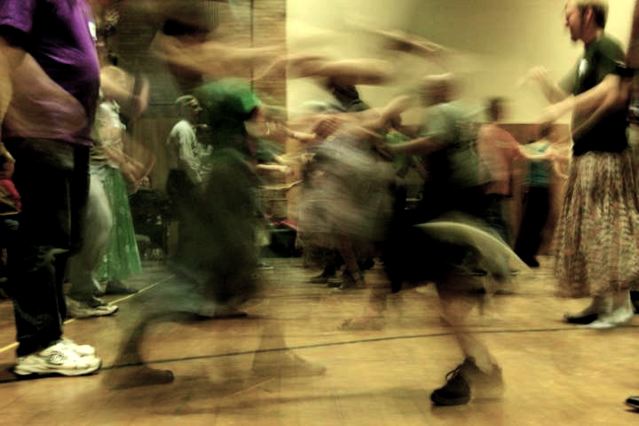I still remember the first time I experienced contra dancing.
This was back in Tucson where I lived for all of my life before moving to Goshen. An older friend from church invited my sister and me to a Saturday night dance. She happened to be my sister’s mentor and a contra dancing fanatic. I had spent hours at church camp-outs in the desert sitting around tune books and playing through Irish tunes with her.Needless to say, she guessed correctly that I would fall in love with the whole experience. I still have warm fuzzy feelings from that night in the Methodist church hall, surrounded by music and smiling, friendly people who took me in their arms and helped me weave my way through the steps. I remember the feeling of elation I had the first time I learned how to lean back in a swing and let physics do the work.
For those of you who have never been to a contra dance, my goal here is to convince you to try it.
Imagine this: you and your friends have a meal together and then you make your way to a church, a gymnasium or other building with some great springy wood floors. (The wood floors are a must.) You wear dance shoes or sneakers, long flowing skirts or comfortable pants. As you walk into this big room, you pay a modest amount of money to support the hardworking people who bring the whole thing together, the musicians who will play live dance tunes for three hours, and the cost of the space — all for your dancing enjoyment.
Think of contra dancing as a cross between square and line dancing. Or if you’ve never experienced either of these, you might think about the “walk-a-mile” where you spend a little time with many different conversation (or in this case dancing) partners. Contra dancing allows you to dance with almost everyone in attendance throughout the evening. Anyone can ask anyone to dance, and there is no assumed interest beyond the dance. It’s a great social activity, and the music, laughter and physicality of the dance all contribute to an experience of shared humanity.
While I love dancing, especially swinging wildly, I have to admit that what really gets me excited is the music. I discovered how much I enjoy playing music for dances when I found out that the Tucson dance had an “open band” once a month. This means that anyone who plays an instrument that is suited to the style, and is familiar with the repertoire, is welcome to join the always-unique assemblage of musicians. The first time I participated, I was welcomed, but seated in the back. I think the regulars weren’t sure if I would know many tunes.
The second time I played in the open band, they had me sit in front, and even gave me a mic. This was a bit intimidating, but I realized how important it is to be able to respond in the moment — to the other musicians, to the musical demands of the particular choreography and, most importantly, to the dancers.
Through more experience playing for several dances in both Arizona and Indiana (Goshen and Fort Wayne) I have learned how much I love creating a special connection through my music to the dancers. Every single contra dance is different: acoustics, choreography, skill level of the dancers and many other factors can vary. But what stays constant is the light in people’s faces while they dance. I love noticing how when I change something in the way I play a phrase, the dancers respond in different ways.
I can think of few things more heartwarming than people dancing, laughing and sharing together for three hours on a Saturday night, and I am always honored to be a part of it.
If you think you may want to try contra dancing, check out godancing.org.
I’ll see you there.


